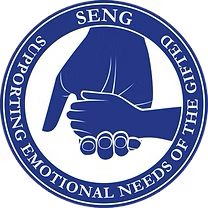This article is intended to educate parents/guardians and educators with history, statistical data, and best practices that can be shared with gifted children pertaining to what LGBTQ+ children and adolescents face in schools even though their children might not be LGBTQ+. Hosting discussions related to this history and statistics serve to encourage our gifted children/adolescent youth to support this oppressed group.
Therefore, parents/guardians should assist and encourage their gifted children/adolescents in recognizing that being gifted includes the ability to perceive injustice when it exists, to identify creative alternatives, and to use their intellectual skills toward finding solutions. This will ultimately lead gifted children/adolescents to feel enriched when they use their talents to shape a better world for others. Gifted youth are also keenly aware of the flaws and imperfections of their parents, teachers, and political leaders. They try to grasp the enormity of injustice, war, politics, natural disasters and existential mysteries, and may respond with sadness, anxiety, anger, or even indifference when the burden seems too overwhelming. Notably they are gifted, but they are still children.
It is important to provide the history of Pride and the Gay Rights Movement to our “straight” gifted child/adolescents and those who are gifted LGBTQ+ to help them understand and support these individuals’ rights and issues of inequality. Starting at an early age, it is evident that young, gifted children and adolescents exhibit acute moral sensitivity. Young, gifted children and adolescents are more inclined to hijack the responsibility and burden of others. There is an innate need to agonize and covet others’ internal strengths. This transpires to overcome their achievements by being able to ease other’s pain and suffering, be more empathetic, and demonstrate an advanced ability to think in the abstract pertaining to concepts of fairness and justice (Sedillo, 2013).
What is the history and catalyst behind the many Pride Celebrations held throughout the world? Parades, picnics, marches, rallies all honor the Stonewall Riots, an event that took place in New York in the early morning hours of June 28, 1969, at the Stonewall Inn in Greenwich Village. The riots are frequently cited as the first instance in American history when people in the homosexual community fought back against a government-sponsored system that persecuted sexual minorities. The Stonewall Riots marked the start of the Gay Rights Movement in the United States and around the world.
Police raids on gay bars were routine in the 1960s, and the patrons came to expect them. On June 28, 1969, when the police entered the Stonewall Inn and attempted to arrest patrons, those who refused to leave helped form a crowd that grew into a riot. The ensuing clashes, arrests, and public reaction galvanized activism and led to organized Pride events.
Within six months there were gay activist organizations and newspapers promoting rights for gays and lesbians. On June 28, 1970, the first Gay Pride marches took place in New York, Los Angeles, San Francisco and Chicago to commemorate the Stonewall Riots. Today, Pride events are held throughout the world to commemorate Stonewall.
The history, statistical data, and best practices presented in this article can be shared with gifted children, even if they might not be LGBTQ+. Facilitated discussions related to this history and the following statistics can help our gifted children/adolescent youth understand why it is important to support this oppressed group. The HRC report Growing Up LGBT in America (2017) surveyed more than 10,000 LGBT-identified youth ages 13–17 and documents many of the difficulties they face. According to HRC’s survey, LGBT students reported being harassed at school both verbally and physically at roughly twice the rate of non-LGBT adolescents. The survey revealed heightened stressors in middle and high school settings such as bullying, lack of role models, and negative educational outcomes.
For LGBTQ+ students, faculty and staff, the school environment can pose numerous threats and obstacles. Hateful language, physical and emotional harassment and the threat of physical violence are realities. Even in more supportive environments, silence on LGBTQ+ issues is itself a painful message. Below are recent statistics on LGBTQ+ youth and the school environment:
- GLBTQQ+ students are more than twice as likely to have skipped school in the past month because of safety concerns.
- GLBTQQ+ students are less likely to report that school staff intervened in homophobic and sexist remarks (GLSEN, 2016).
- Sixty-five percent of LGB people experience homophobic bullying.
- Ninety-seven percent of LGB students hear derogatory phrases such as “dyke” or “poof” used in school; half of teachers fail to respond.
- Forty percent of homeless youth identify as LGBTQ+ (Williams Institute, 2012).
- Forty percent of suicide victims are part of the GLBT community.
- Ninety-eight percent of LGBT pupils hear “that’s so gay” at school.
- Seventy-five percent of young LGBT people in faith schools experience homophobic bullying and are less likely to report it.
- Only one quarter of schools say that homophobic bullying is wrong in their school.
- Thirty percent of LGBT pupils report that adults are responsible for homophobic incidents at their school (The School Report – Stonewall, 2007).
- Ninety percent of 15–24-year-olds have been called names because of their sexuality (Profiles of Prejudice, Stonewall and Mori, 2003).
- The majority of those out or perceived as transgender while in school experienced mistreatment, including verbal harassment and physical attack (54%) or sexual assault (24%); 17% left school as a result. Forty percent of transgender people attempted suicide compared to 4.6% of the general population (2015 National Center for Transgender Equality).
The preceding statistics detail harm, oppression and abuse within school systems. How can parents/guardians and educators assist their (gifted) children in seeking justice for others who are persecuted? They can assist heterosexual and LGBTQ+ gifted children/adolescents by displaying Rainbow Pride Flags, purchasing entrance tickets to attend Annual Pride Festivals, signing up to hear local lesbian poets, or volunteering to help design a Pride parade float. The following suggestions are best practices for parents/guardians and educators:
● Educate yourself and your child about LGBTQ+ topics, issues, questions and concerns. Locate materials and resources about LGBTQ+ culture and history. Many mainstream histories omit LGBTQ+ milestones; locate age-appropriate readings such as Pride Celebrating Diversity & Community (Robin Stevenson), This Day In June (Gayle E. Pitman), and Gay & Lesbian History for Kids (Jerome Pohlen).
● Acknowledge that your gifted child/adolescent will challenge authority and question rules. Remind them that many change agents broke rules (Gandhi, Harvey Milk, Martin Luther King). Support their sense of justice, and encourage constructive actions like letter-writing to challenge unfair laws or practices.
● Join the LGBTQ+ movement by becoming an ally and demonstrating pride, love, and acceptance. Becoming an ally honors past activists and can bring awareness to your family and community. Celebrate Pride Month by attending local Pride events when appropriate. Respect your child’s readiness to show public support; some gifted children may be knowledgeable but not ready to be in the limelight, or they may be exploring their own identity. Parents should help gifted children develop the social and emotional skills to manage adult-oriented situations and should honor their questions and anxieties with understanding and respect.
REFERENCES
Durso, L. E., & Gates, G. J. (2012). Serving our youth: Findings from a national survey of service providers working with lesbian, gay, bisexual, and transgender youth who are homeless or at risk of becoming homeless. Retrieved from The Williams Institute: http://williamsinstitute.law.ucla.edu/wp-content/uploads/Durso-Gates-LGBT-Homeless-Youth-Survey-July-2012.pdf
GLSEN. (2016). Teasing to Torment: School Climate Revisited. Retrieved from https://www.glsen.org/sites/default/files/TeasingtoTorment%202015%20FINAL%20PDF%5B1%5D_0.pdf
HRC (2017). Growing Up LGBT in America. Retrieved from https://www.hrc.org/youth-report
National Center for Transgender Equality (2015). Transgender Survey Report. Retrieved from https://transequality.org/issues/national-transgender-discrimination-survey
Sedillo, P. J. (2013). A retrospective study of gay gifted, young adult males’ perceptions of giftedness and suicide (Unpublished doctoral dissertation). University of New Mexico, Albuquerque.
Stonewall (2003). Profiles of Prejudice. Retrieved from https://www.stonewall.org.uk/resources/profiles-prejudice-2003
Stonewall (2017). The School Report. Retrieved from http://www.stonewall.org.uk/school-report-2017

